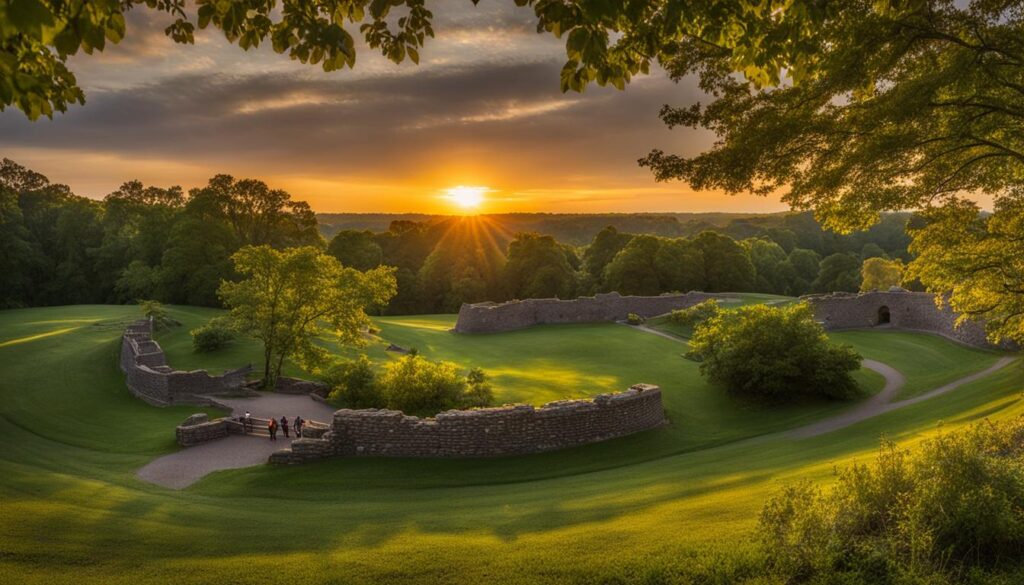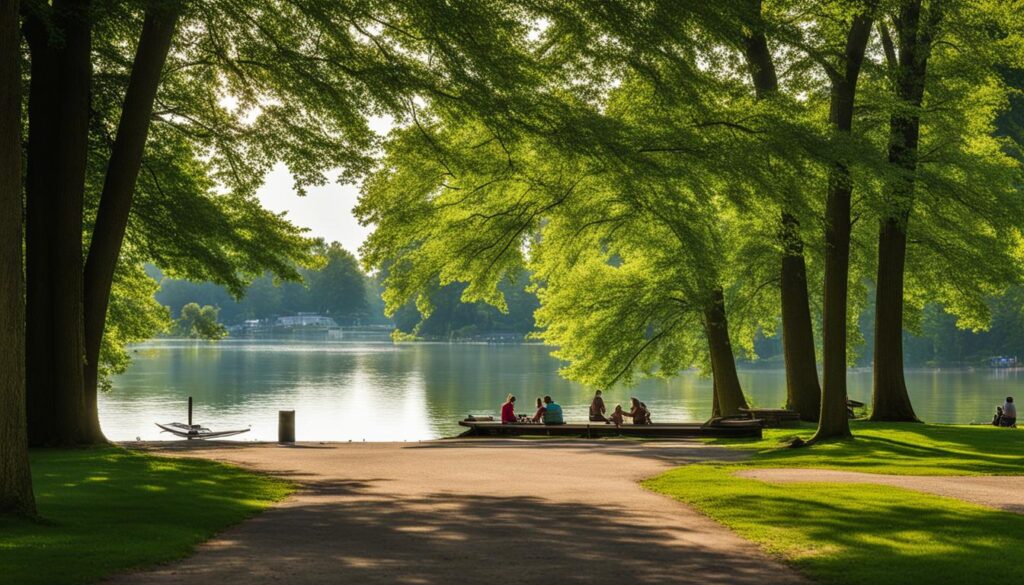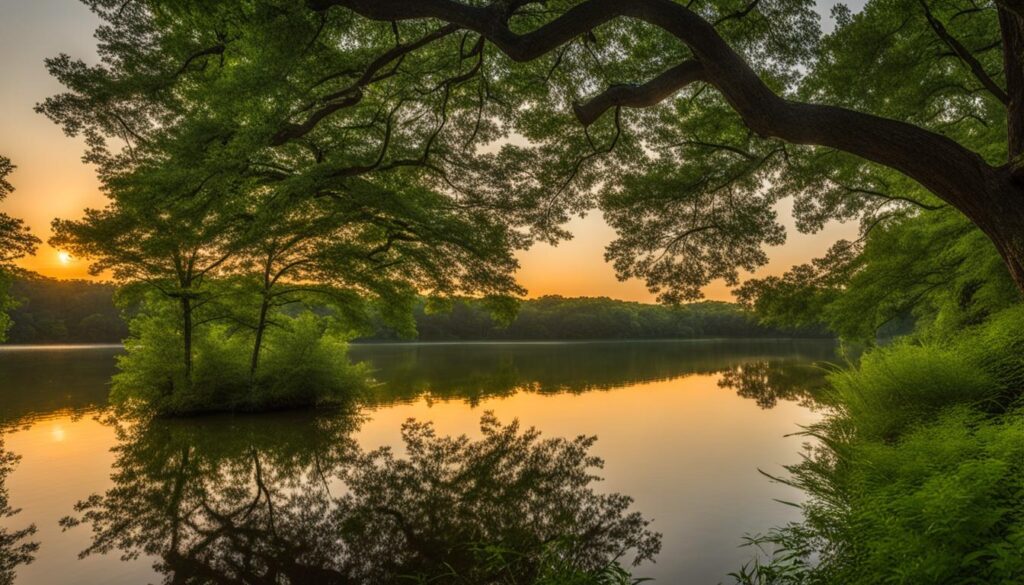Nearly 2000 years ago, American Indians built dozens of monumental mounds and earthen enclosures in southern Ohio. These prehistoric earthworks, created by the ancient mound builders, are a testament to the rich cultural heritage and native American history of the region. Today, these archaeological sites are preserved and showcased at the Hopewell Culture National Historical Park, a designated UNESCO World Heritage site.
At Hopewell Culture National Historical Park, visitors can delve into the fascinating world of the Hopewell culture, experiencing the spirituality and significance of these ancient earthworks. From the imposing burial mounds to the intricately built enclosures, each structure offers a glimpse into the lives and practices of the Native American civilizations that thrived in this area.
Key Takeaways:
- Explore the Hopewell Culture National Historical Park to discover the ancient mound builders’ accomplishments.
- Immerse yourself in the history and spirituality of Native American civilizations.
- Experience the monumental earthworks and learn about their cultural significance.
- Appreciate the preservation efforts of the park as a UNESCO World Heritage site.
- Gain a deeper understanding of Ohio’s rich Native American heritage.
Contents
Essential Information for Visitors

Before planning a visit to Hopewell Culture National Historical Park, it is important to familiarize yourself with essential information. This includes park hours, upcoming events, directions to park sites, accessibility features, safety guidelines, and current weather conditions. By being informed, visitors can make the most of their time at the park and ensure a safe and enjoyable experience.
Park Hours
Plan your visit to Hopewell Culture National Historical Park during the park’s operational hours:
- Monday to Sunday: 9:00 AM – 5:00 PM
Upcoming Events
Stay updated on the exciting events happening at the park. Join in on lectures, workshops, guided tours, and special exhibits. Check the park’s website or contact the visitor center for the latest information on upcoming events.
Directions to Park Sites
Getting to Hopewell Culture National Historical Park is straightforward. The park is located at 16062 State Route 104, Chillicothe, Ohio. Visitors can use GPS or map applications for accurate directions based on their starting location.
Accessibility Features
The park is committed to providing accessibility features to accommodate visitors with disabilities. Accessible paths, ramps, and parking spaces are available to ensure a pleasant experience for all guests. For specific accessibility needs and information, contact the visitor center in advance.
Safety Guidelines
To ensure a safe visit to Hopewell Culture National Historical Park, please adhere to the following safety guidelines:
- Stay on designated paths and trails.
- Do not climb, touch, or disturb the ancient mound structures.
- Observe wildlife from a safe distance and do not feed or approach them.
- Bring adequate water, sunscreen, and insect repellent, especially during warmer months.
- Follow all park regulations and obey signage.
Weather Conditions
Check the current weather forecast before your visit to ensure appropriate attire and preparedness. The park is open year-round, and the weather conditions can vary from season to season. Dress in layers and consider the forecasted temperature, precipitation, and wind conditions.
| Month | Temperature (°F) | Precipitation (inches) |
|---|---|---|
| January | 28 – 39 | 2.6 |
| February | 30 – 43 | 2.1 |
| March | 38 – 54 | 3.6 |
| April | 47 – 66 | 3.9 |
| May | 57 – 75 | 4.4 |
| June | 66 – 83 | 4.2 |
| July | 70 – 87 | 4.1 |
| August | 68 – 86 | 3.7 |
| September | 61 – 80 | 2.9 |
| October | 49 – 68 | 2.5 |
| November | 39 – 54 | 3.2 |
| December | 30 – 43 | 3.0 |
Kindly note that weather conditions are subject to change. Always check the latest forecast before your visit.
Park Highlights and Activities

Hopewell Culture National Historical Park offers a range of highlights and activities for visitors to explore. These include:
Visiting the Museum
At the museum, visitors can immerse themselves in the rich history of the Hopewell culture. Significant Hopewell artifacts are displayed, shedding light on the intricate skills and artistic abilities of these ancient mound builders. The museum provides a fascinating insight into the culture and achievements of the Hopewell civilization.
Walking Among the Reconstructed Burial Mounds
One of the park’s highlights is the opportunity to walk among the reconstructed burial mounds. These mounds were created by the Hopewell culture for ceremonial and spiritual purposes. Exploring these ancient structures allows visitors to connect with the past and experience the awe-inspiring craftsmanship of the Hopewell people.
Following the Nature Trail
To fully appreciate the park’s natural beauty, visitors can follow the nature trail. This trail offers a serene escape into the surrounding woodlands and allows for moments of reflection and tranquility. Walking along the trail provides an opportunity to observe the flora and fauna that thrive in the park’s diverse ecosystem.
Participating in Ranger-Guided Tours
Ranger-guided tours are available for those seeking a deeper understanding of the history and significance of the ancient earthworks. Knowledgeable guides provide valuable insights into the rituals, traditions, and cultural significance of the Hopewell culture. These tours offer an engaging and educational experience for visitors of all ages.
Accommodations and Services

While the Hopewell Culture National Historical Park does not provide overnight accommodations, there are various lodging options available in nearby communities for visitors to choose from. These accommodations offer a comfortable and convenient stay, allowing guests to fully immerse themselves in the park’s rich cultural heritage.
For those seeking information and assistance, the park features a visitor center, equipped with friendly staff who can provide in-depth knowledge about the park’s attractions. The visitor center also offers a range of park resources and facilities, including restrooms and picnic areas, ensuring that visitors have a pleasant and convenient experience during their visit.
Moreover, the park takes pride in its Junior Ranger program, designed to engage younger visitors in the park’s history and significance. This program provides an opportunity for children to learn about the ancient mound builders and their contributions to Native American civilizations. By participating in the Junior Ranger program, young visitors can earn special badges and develop a deeper connection with the park.
The accommodations, visitor center, and Junior Ranger program are all essential elements of the Hopewell Culture National Historical Park experience, enhancing visitors’ understanding and enjoyment of this remarkable archaeological site.
Exploring the Area
When visiting Hopewell Culture National Historical Park, there are plenty of nearby attractions and points of interest to explore. This region is steeped in cultural and historical significance, offering visitors a chance to delve deeper into the Native American heritage of Ohio.
One of the highlights is the opportunity to explore other archaeological sites in the area. These sites provide a glimpse into the ancient civilizations that once thrived in this region, offering valuable insights into their practices and way of life. By visiting these sites, visitors can gain a broader understanding of the Hopewell culture and its place within the larger Native American history.
Additionally, museums in the vicinity showcase artifacts and exhibits related to the region’s cultural heritage. These museums offer a comprehensive overview of the Native American civilizations that inhabited the area, providing context to the Hopewell Culture National Historical Park. It’s a chance to see firsthand the material culture and artistic expressions of these ancient societies.
Cultural landmarks are another aspect of the area worth exploring. These landmarks may include sacred sites, spiritual centers, or significant locations tied to Native American traditions. By visiting these cultural landmarks, visitors can gain a deeper appreciation for the spiritual and cultural significance that shaped the Hopewell culture and its enduring impact on the region.
Overall, exploring the area surrounding Hopewell Culture National Historical Park offers a comprehensive exploration of Ohio’s cultural landscape. It allows visitors to go beyond the park boundaries and connect with the broader Native American heritage of the region.
| Nearby Attractions | Points of Interest | Cultural Sites |
|---|---|---|
| 1. Fort Ancient | 1. Native American burial mounds | 1. Serpent Mound |
| 2. The Mound City Group | 2. Nature preserves and scenic landscapes | 2. Adena Mansion and Gardens |
| 3. Great Seal State Park | 3. Historic villages and ancient earthworks | 3. Cahokia Mounds State Historic Site |
| 4. Ohio Historical Center | 4. Museums showcasing Native American art and artifacts | 4. Hocking Hills State Park |
| 5. Chillicothe | 5. Sacred sites and spiritual centers | 5. Sun Watch Indian Village |
Park History and Significance

The history of Hopewell Culture National Historical Park is deeply rooted in the ancient Native American civilizations known as the Hopewell culture. Nearly 2000 years ago, these remarkable people constructed monumental earthworks within the park’s boundaries for religious and ceremonial purposes. These earthworks, which include mounds and enclosures, served as sacred spaces where the Hopewell culture engaged in feasts, rituals, funerals, and rites of passage.
The significance of Hopewell Culture National Historical Park lies in its preservation and protection of these ancient structures. They offer a fascinating glimpse into the spiritual and cultural practices of the Hopewell people, allowing visitors to connect with a bygone era and gain insights into the lives of the ancient Native American civilization.
By exploring the park and studying its history, visitors have the opportunity to develop a deeper appreciation for the ancestral heritage of the Native American civilizations that once thrived in this region. The Hopewell culture’s achievements, as evidenced by the awe-inspiring earthworks, contribute to the broader narrative of Native American history and cultural legacy.
Immerse yourself in the rich history and significance of Hopewell Culture National Historical Park to better understand the enduring legacy of the Hopewell culture and the profound impact of Native American civilizations.
Key Features of Hopewell Culture National Historical Park
| Feature | Description |
|---|---|
| Ancient Earthworks | Preserves monumental mounds and enclosures |
| Native American Heritage | Offers insights into the Hopewell culture |
| Spiritual and Cultural Significance | Connects visitors with the ancient past |
| Preservation Efforts | Safeguards the park’s historical structures |
| Education and Exploration | Provides a learning experience for visitors |
Immerse yourself in the rich history and significance of Hopewell Culture National Historical Park to better understand the enduring legacy of the Hopewell culture and the profound impact of Native American civilizations.
Planning Your Visit

To make the most of your visit to Hopewell Culture National Historical Park, it is important to plan ahead. Here are some visitor tips, along with information on the best time to visit and park regulations, to help you optimize your experience and fully immerse yourself in the rich cultural heritage of the site.
Visitor Tips
- Wear comfortable shoes and dress appropriately for outdoor activities.
- Bring sunscreen, bug spray, and water to stay hydrated.
- Pack a picnic lunch to enjoy at one of the park’s designated areas.
- Don’t forget your camera to capture the beauty of the ancient earthworks.
- Take your time to explore each site and soak in the history and significance.
Best Time to Visit
The best time to visit Hopewell Culture National Historical Park is during the spring and fall seasons when the weather is mild. These seasons offer pleasant temperatures and colorful foliage, enhancing the overall experience of exploring the park. However, each season has its own unique charm, so plan your visit based on your personal preferences.
Park Regulations
To ensure everyone’s safety and the preservation of the park, there are certain regulations that visitors must follow. These regulations include:
- Stay on designated trails and paths.
- Do not climb or disturb the earthworks and mounds.
- Respect the park’s wildlife and plant life, refraining from picking flowers or disturbing animals.
- Dispose of trash in designated bins.
- Follow any additional guidelines provided by park rangers and staff.
By planning your visit, following visitor tips, considering the best time to visit, and adhering to park regulations, you can ensure a memorable and enriching experience at Hopewell Culture National Historical Park.
Conclusion
Hopewell Culture National Historical Park is a remarkable testament to the ancient mound builders and their profound impact on Native American history and cultural heritage. By exploring the park’s awe-inspiring ancient earthworks, participating in engaging park activities, and immersing themselves in the area’s rich history, visitors have the opportunity to develop a profound appreciation for the Hopewell culture and the enduring legacy they have left behind. A visit to Hopewell Culture National Historical Park is a unique chance to connect with the past, gain a deeper understanding of the Native American civilizations that once thrived in these lands, and preserve their sacred traditions.
The park’s preservation and showcase of the monumental mounds and earthen enclosures that were used for ceremonies and rituals speak to the unparalleled craftsmanship and sophisticated spiritual practices of the Hopewell culture. The insights gained from studying and appreciating the park’s history allow us to honor and respect the ancestral heritage of Native American civilizations.
When visiting Hopewell Culture National Historical Park, visitors not only witness the incredible architectural achievements of the ancient mound builders but also encounter the spirituality and cultural significance that define the park. It serves as a poignant reminder of the vitality and ingenuity of Native American cultures throughout history, highlighting the importance of preserving and celebrating their cultural heritage for future generations.
FAQ
What is the Hopewell Culture National Historical Park?
The Hopewell Culture National Historical Park is an archaeological site in southern Ohio that preserves and showcases the rich cultural heritage and native American history of prehistoric earthworks built by the ancient mound builders.
What are the park’s hours of operation?
The park’s hours of operation vary, so it’s best to check the official website or contact the park for the most up-to-date information regarding opening and closing times.
Are there any upcoming events at the park?
Yes, the park often hosts special events and programs. Check the park’s website or contact the visitor center for information on upcoming events and activities.
How can I get directions to the park sites?
The park provides detailed directions on its website, including addresses and GPS coordinates for each site. Alternatively, visitors can use navigation apps or maps for directions to the park.
What accessibility features are available at the park?
The park strives to accommodate visitors of all abilities. Accessible parking, pathways, and restrooms are available, and the visitor center offers additional accessibility services. It’s recommended to check the park’s website or contact the visitor center for specific information and assistance.
What safety guidelines should I be aware of when visiting the park?
The park advises visitors to stay on designated trails, avoid climbing on the mounds, and be cautious of their surroundings. It’s also important to be prepared with appropriate clothing, footwear, and sun protection. Additionally, visitors should adhere to any posted rules and regulations for the safety of themselves and the preservation of the site.
Where can I find information about the current weather conditions at the park?
The park’s website or contacting the visitor center will provide the most accurate information regarding current weather conditions at the park.
What are the highlights and activities to explore at the park?
Visitors can enjoy several highlights and activities at the park, including visiting the museum to see significant Hopewell artifacts, exploring the reconstructed burial mounds, walking the nature trail to experience the park’s natural beauty, and joining ranger-guided tours to learn about the history and significance of the earthworks.
Can I stay overnight at Hopewell Culture National Historical Park?
No, there are no overnight accommodations within the park. However, there are a range of lodging options available in nearby communities.
What services are provided at the park’s visitor center?
The visitor center offers park information, resources, and facilities such as restrooms and picnic areas. Visitors can also inquire about park programs, Junior Ranger activities, and get assistance from the park staff.
Is there a Junior Ranger program available for younger visitors?
Yes, the park offers a Junior Ranger program, which allows younger visitors to engage with the park’s history and earn special badges. Details and program materials can be obtained at the visitor center.
Are there other attractions to explore in the surrounding area?
Yes, the region near Hopewell Culture National Historical Park is rich with cultural and historical sites. Visitors can explore nearby attractions, such as other archaeological sites, museums, and cultural landmarks, to gain a broader understanding of the region’s Native American heritage.
What is the historical significance of Hopewell Culture National Historical Park?
The park preserves the ancient earthworks constructed by the Hopewell culture, which thrived in the region nearly 2000 years ago. These earthworks have significant cultural and religious importance, providing insights into the spiritual and cultural practices of the Hopewell culture and other Native American civilizations.
How should I plan my visit to Hopewell Culture National Historical Park?
To make the most of your visit, it is recommended to plan ahead. Visitors can find helpful tips, including the best time to visit, park regulations, and recommendations for exploring the park, on the official website or by contacting the park’s visitor center.
What is the enduring legacy of the ancient mound builders at Hopewell Culture National Historical Park?
The ancient mound builders left behind a lasting cultural heritage and contributed significantly to Native American history. A visit to Hopewell Culture National Historical Park allows visitors to connect with the past and gain a greater understanding of the Native American civilizations that once thrived in the region.






